Since I Never Beta My Work, My Goal Is To Find A Funny Way To Say It In The Tags.
Since I never beta my work, my goal is to find a funny way to say it in the tags.
The typical one I use is “no beta I die like a red shirt”, but last time I used a “no beta I die like Splinter” for a 2012 TMNT fic, and my last DS9 fic I wrote “no beta I die like a Jem’Hadar”.
And idk I think it’s hilarious. I can’t wait to get to my next fic and write something wild.
More Posts from Lokisbur and Others
WEBSITES FOR WRITERS {masterpost}
E.A. Deverell - FREE worksheets (characters, world building, narrator, etc.) and paid courses;
Hiveword - Helps to research any topic to write about (has other resources, too);
BetaBooks - Share your draft with your beta reader (can be more than one), and see where they stopped reading, their comments, etc.;
Charlotte Dillon - Research links;
Writing realistic injuries - The title is pretty self-explanatory: while writing about an injury, take a look at this useful website;
One Stop for Writers - You guys... this website has literally everything we need: a) Description thesaurus collection, b) Character builder, c) Story maps, d) Scene maps & timelines, e) World building surveys, f) Worksheets, f) Tutorials, and much more! Although it has a paid plan ($90/year | $50/6 months | $9/month), you can still get a 2-week FREE trial;
One Stop for Writers Roadmap - It has many tips for you, divided into three different topics: a) How to plan a story, b) How to write a story, c) How to revise a story. The best thing about this? It's FREE!
Story Structure Database - The Story Structure Database is an archive of books and movies, recording all their major plot points;
National Centre for Writing - FREE worksheets and writing courses. Has also paid courses;
Penguin Random House - Has some writing contests and great opportunities;
Crime Reads - Get inspired before writing a crime scene;
The Creative Academy for Writers - "Writers helping writers along every step of the path to publication." It's FREE and has ZOOM writing rooms;
Reedsy - "A trusted place to learn how to successfully publish your book" It has many tips, and tools (generators), contests, prompts lists, etc. FREE;
QueryTracker - Find agents for your books (personally, I've never used this before, but I thought I should feature it here);
Pacemaker - Track your goals (example: Write 50K words - then, everytime you write, you track the number of the words, and it will make a graphic for you with your progress). It's FREE but has a paid plan;
Save the Cat! - The blog of the most known storytelling method. You can find posts, sheets, a software (student discount - 70%), and other things;
I hope this is helpful for you!
(Also, check my blog if you want to!)
Some tips for using a few words to describe voices:
1. Tone Words: Use tone words to convey the emotional quality of a voice. For example, you can describe a voice as "melodic," "soothing," "sharp," "gentle," or "commanding" to give readers a sense of the tone.
2. Pitch and Range: Mention the pitch and range of the voice. Is it "deep," "high-pitched," "raspy," or "full-bodied"? This can provide insight into the character's age, gender, or emotional state.
3. Accent and Diction: Describe the character's accent or diction briefly to give a sense of their background or cultural influences. For instance, "British-accented," "Southern drawl," or "formal."
4. Volume: Mention the volume of the voice, whether it's "whispering," "booming," "murmuring," or "hushed."
5. Quality: Use terms like "velvet," "silken," "gravelly," "honeyed," or "crisp" to convey the texture or quality of the voice.
6. Rate of Speech: Describe how fast or slow the character speaks, using words like "rapid," "slurred," "measured," or "rambling."
7. Mood or Emotion: Indicate the mood or emotion carried by the voice. For example, a "quivering" voice may convey fear or anxiety, while a "warm" voice may express comfort and reassurance.
8. Resonance: Describe the resonance of the voice, such as "echoing," "nasal," "booming," or "tinny."
9. Timbre: Mention the timbre of the voice, using words like "rich," "thin," "clear," or "smoky."
10. Cadence: Highlight the rhythm or cadence of speech with descriptors like "staccato," "lilting," "rhythmic," or "halting."
11. Intonation: Convey the character's intonation by saying their voice is "sarcastic," "apologetic," "confident," or "questioning."
12. Vocal Characteristics: If applicable, mention unique vocal characteristics, like a "lisp," "stutter," "drawl," or "accented 'r'."
OK Y’ALL IT’S LIVE!!!!
All Saints Street crack video!!
apparently this is not common knowledge among punk diy sewists but if you’re sewing patches / doing any sewing that requires pushing a needle through multiple layers of fabric, use a needle grip. they’re little rubber things that have excellent grip on the metal needle so you don’t have to pinch the needle as hard. you will save your fingers soooo much unnecessary pain.
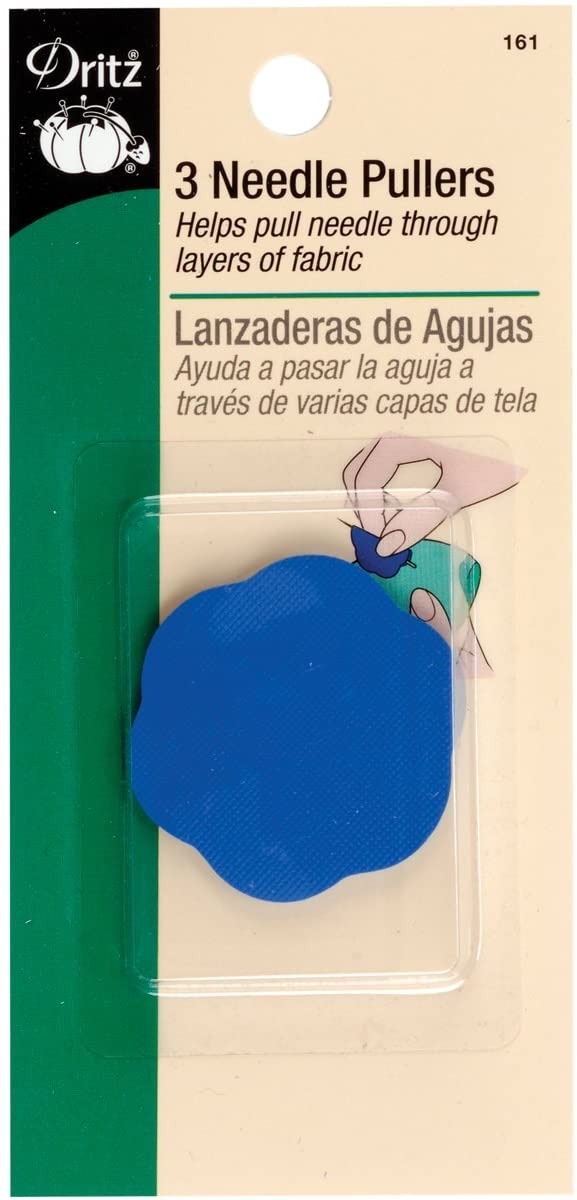

there’s two main types. the basic type is just a little circle of rubber that you fold around your needle, and the fancier type is a little rubber cap for your fingertips. they’re very cheap, under five bucks for the fancier kind and less for the basic, and they last forever. you can buy nice ones from your local craft store or steal them from the quilting section walmart idc. if you’re in a pinch (pun intended) and can’t go out, if you have a non-slip mat under a rug, cut off a little corner and that will work decently. please treat your fingers kindly <3
Imagine receiving this kind of comments on a fic you wrote 4 years ago and in which you DID add a beta tag (which is "What is a beta?", and considering the lack of A/B/O dynamic, it pretty much is about betaing your work or not)...
Like y'all should learn that you can't fucking drop this kind of comment????
"your work was great!! You write badly though" like stfu?
It's also a fucking FANfic?? If you want to read professional stuff then go read a dang book.
Do I love it when someone's grammar is bad in a fic? No. But also they wrote that for fun and the story is great, so I don't really care that much.

Lmao fuck you????
Chapter: 1/1
Series: Part 2 of In Purgatory's Shadow and By Inferno's Light
Words: 1281
Language: English
Fandom: Star Trek, Star Trek: Deep Space Nine
Rating: Not Rated
Warnings: Creator Chose Not To Use Archive Warnings
Relationship: Garashir
Characters: Julian Bashir, Elim Garak
Additional Tags: Dissociation, Crying, Hugs, Claustrophobia, Episode: s05e15 By Inferno's Light
They need to invent writing for sleepy tired people curled up in bed eyes closed and dreaming
Visible Mending
Introduction:
Visible mending is a decorative way to fix up an item. Instead of trying to make your mend as invisible as possible, the idea is to make it part of the garment's design.
Visual mending is not a single technique: it's more of a mindset. If you've got an item you love, it deserves to be mended, and if you're going to put that love into stitches, why not show them off?
That being said, there are some specific techniques that are popular with visible menders. Let's take a look!
Sashiko:
Sashiko is a type of traditional Japanese embroidery that is used to both decorate and reinforce fabric. In visible mending, sashiko is often used to cover up holes with patches or to reinforce thinning fabric. This technique uses a variation on the running stitch.

(Image source)
Some resources on sashiko:
SashiCo on YouTube: sashiko livestreams and information on the cultural aspect of sashiko.
Written tutorial by Upcycle Stitches.
Free sashiko templates by TheSpruceCrafts.
Fixing jeans with sashiko by Soluna Collective.
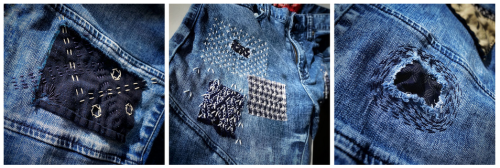
(Image source)

(Image source)
Embroidery:
Regular embroidery is also a popular technique to accentuate your mends. Check out my embroidery 101 post to learn how to get started. You can embroider patches, or use embroidery to hide or accentuate any stitches you've made to fix holes. Embroidery's also a great way to cover up stains.
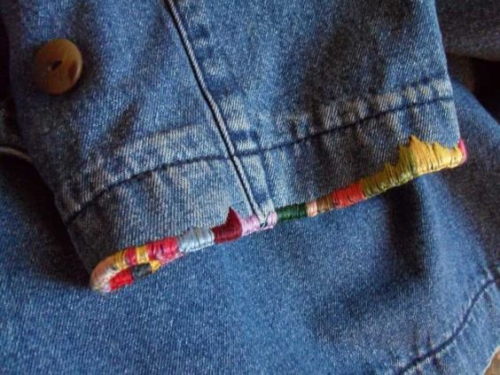
(Image source)
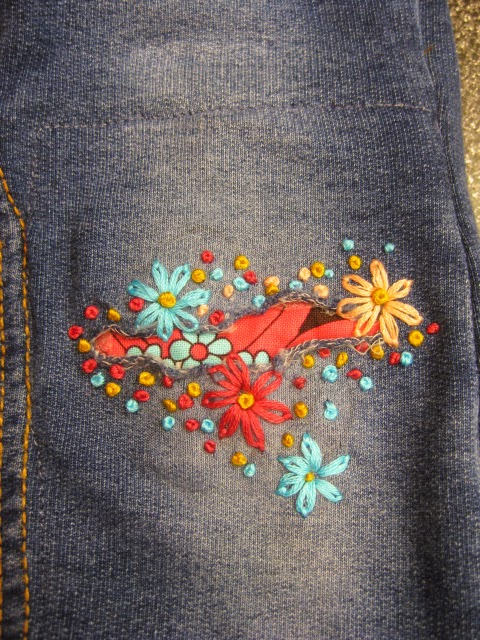
(Image source)
Patches:
There are many ways to add patches to a garment. My tutorial on patches is a good place to start if you want to make custom-shaped patches to sew on top of your fabric. You can also sew your patch on the inside of your garment and have it peek out from beneath the hole you're trying to fix. Fun ideas for this are lace or superheroes.
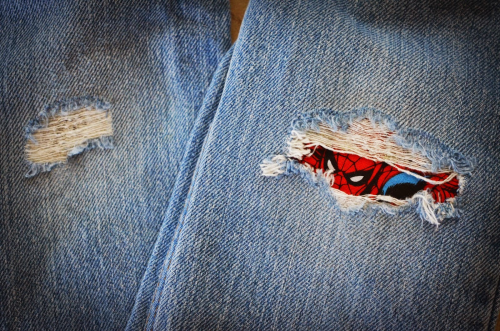
(Image source)

(Source)
Darning:
Darning is a technique used to repair holes in fabric by using running stitches to weave extra fabric over the hole as to fill it up again. While traditionally darning is done in an invisible way by using the same colour of thread as your fabric, you can also use contrasting colours to accentuate your fix. Check out this written tutorial on darning by TheSpruceCrafts.
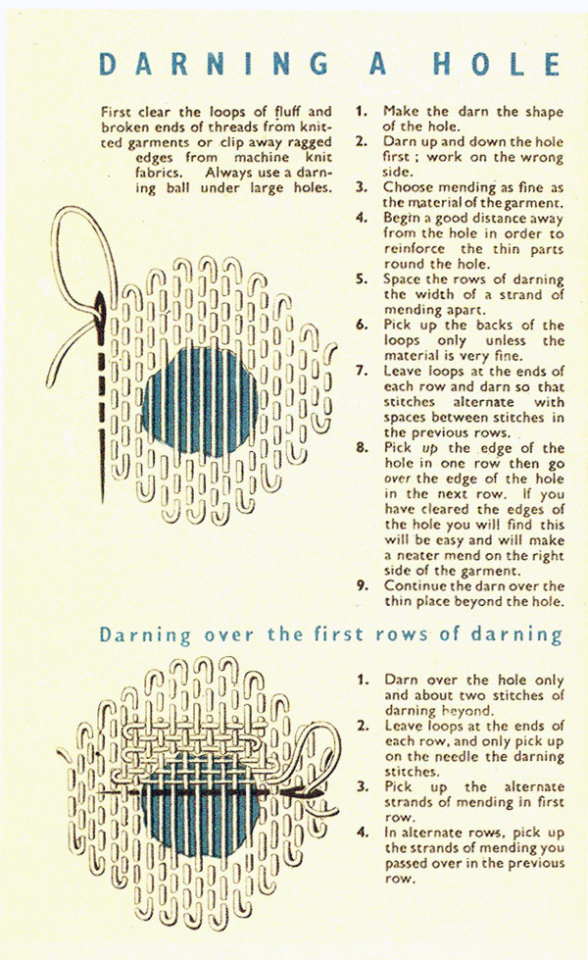
(Image source)
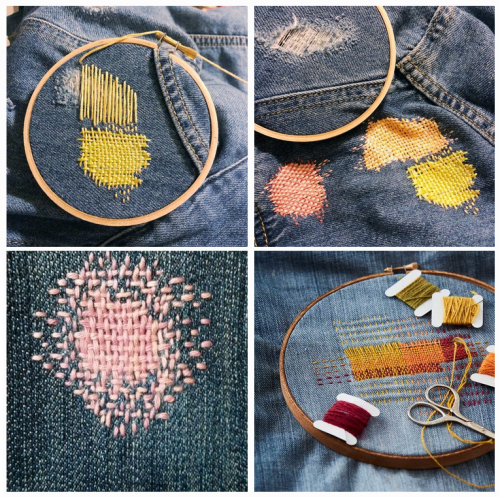
(Image source)
Conclusion:
Visible mending is a creative way to fix up your clothes and give them some personality at the same time.
You should be proud of the fact that you took the time and learned the necessary skills needed to mend your clothes! Show off what you did!
A fun side effect of wearing these obvious mends is that people will notice them. They'll remember your fixes the next time they're faced with a hole in their wardrobe, and it will make them more likely to try it for themselves.
These are just a few ways to visibly mend your garments. Want more inspiration? Check out Pinterest or r/Visiblemending on Reddit.
I've finished backing all my fics on a drive.
If ever you do not have an AO3 account but still want to read my work, you can come ask me in DMs.
By accessing my work, no matter the platform, you are forbidden to claim it as your own, to use it without my permission and to feed it to any and all kind of AI.
You are however permitted to share the AO3 links, to have fun with any kind of inspiration it gives you.
If you ever are inspired and share the fruit of your fun, think about tagging me so I can see what you've done!
For reference mine was I was so mad at the canon ending for my favourite character in an otome game that I wrote fanfic to fix it
-
 starcats1219 liked this · 4 years ago
starcats1219 liked this · 4 years ago -
 lokisbur reblogged this · 4 years ago
lokisbur reblogged this · 4 years ago

xey/xem French Don't be fooled, I'm a platypus, I don't much stuff (art side account)
288 posts